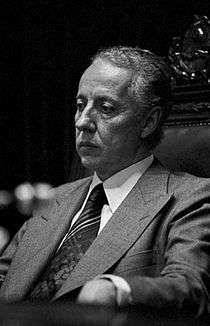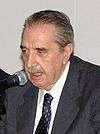1983 Argentine general election
The Argentine general election of 1983 was held on 30 October and marked the return of constitutional rule following the self-styled National Reorganization Process dictatorship installed in 1976. Voters fully chose the president, governors, mayors, and their respective national, province and town legislators; with a turnout of 85.6%.
| |||||||||||||||||||||||||||||
600 members of the Electoral College 301 votes needed to win | |||||||||||||||||||||||||||||
|---|---|---|---|---|---|---|---|---|---|---|---|---|---|---|---|---|---|---|---|---|---|---|---|---|---|---|---|---|---|
| Registered | 17,929,951 | ||||||||||||||||||||||||||||
| Turnout | 85.61% | ||||||||||||||||||||||||||||
| |||||||||||||||||||||||||||||
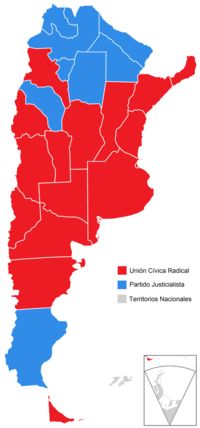 Most voted party by province. | |||||||||||||||||||||||||||||
| |||||||||||||||||||||||||||||
Background
In 1976 the military announced a coup d'état against President Isabel Perón with problems of financial instability, inflation, endemic corruption, international isolation and violence that typified her last year in office. Many citizens believed the National Reorganization Process, the junta's government, would improve the general state of Argentina. As that regime's third dictator, General Leopoldo Galtieri, awoke in the early hours of June 18, 1982 to find a letter requesting he resign, however, he had no doubt that the Process had run its course. Against the wishes of Galtieri's commanders, the Joint Chiefs chose Army General Reynaldo Bignone not so much the new President as the usher towards a democratic transition, which President Bignone announced would take place in March 1984. Inheriting an economy struggling under crushing interest rates imposed by the Central Bank Circular 1050, Bignone's new president of the institution, Domingo Cavallo, rescinded the policy in July, a move towards economic liberalization complemented by Bignone's restoring a limited right of assembly and free speech. Argentina's wide array of political parties, jointly pressing for elections through a "Multiparty" convened by centrist UCR leader Ricardo Balbín in 1981, geared for the imminent return to democracy.[1]
Six years of intermittent wage freezes, policies adverse to industry and restrictive measures like the Circular 1050 had left GDP per capita at its lowest level since 1968 and real wages lower by around 40%. Given these conditions, the return of some freedoms quickly led to a wave of strikes, including two general strikes led by Saúl Ubaldini of the CGT labor federation (then the largest in South America). Fanning antagonism on the part of hard-liners in the regime, this led Admiral Jorge Anaya (later court-martialed for gross malfeasance in the 1982 Falklands War) to announce his candidacy for President in August, becoming the first to do so; amid popular jeers of "Anaya canalla" (Anaya the fiend), Bignone immediately thwarted the move.[1]
Amid growing calls for quicker elections, police brutally repressed a December 16, 1982 demonstration in Buenos Aires' central Plaza de Mayo, resulting in the death of one protester and Bignone's hopes for an indefinite postponement of elections. Devoting themselves to damage control, the regime began preparing for the transition by shredding evidence of their murder of 15–30,000 dissidents (most of which were students, academics and labor union personnel uninvolved in the violence Argentina suffered from 1973 to 1976). Hoping to quiet demands that their whereabouts be known, in February 1983 Buenos Aires Police Chief Ramón Camps publicly recognized the crime and asserted that the "disappeared" were, in fact, dead. Provoking popular indignation, Camps' interview forced President Bignone to cease denying the tragedy and, on April 28, declare a blanket amnesty for those involved (including himself).[2]
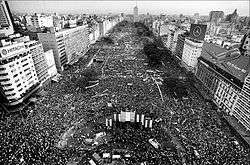
Among the first prominent political figures to condemn the amnesty was the leader of the UCR's progressive wing, Raúl Alfonsín, who easily secured his party's nomination during their convention in July. Alfonsín chose as his running mate Víctor Martínez, a more conservative UCR figure from Córdoba Province. Their traditional opponents, the Justicialist Party, struggled to find candidates for not only the top of the ticket, but for a number of the more important local races, as well. Following conferences that dragged on for two months after the UCR nominated Alfonsín, the Justicialists' left wing (the target of much of the repression before and after the 1976 coup) proved little match for the CGT's influence within the party. They nominated ideological opposites Ítalo Lúder, who had served as acting President during Mrs. Perón's September 1975 sick leave, for President and former Chaco Province Governor Deolindo Bittel as his running mate; whereas Lúder had authorized repression against the left in 1975, Bittel was a populist renowned for his defense of Habeas Corpus during the subsequent dictatorship.[2]
Constrained by time, Alfonsín focused his strategy on accusing the Justicialists, who had refused to condemn Bignone's military amnesty, of enjoying the dictator's tacit support. Alfonsín enjoyed the valuable support of a number of Argentine intellectuals and artists, including playwright Carlos Gorostiza, who devised the UCR candidate's slogan, Ahora, Alfonsín ("Now is the Time for Alfonsín").[3]
Lúder, aware of intraparty tensions, limited his campaign ads and rhetoric largely to an evocation of the founder of the Justicialist Party, the late Juan Perón. Polls gave neither man an edge for the contest, which was scheduled for October 30. A few days for the elections (which a record turnout), the Justicialist candidate for Governor of Buenos Aires Province, Herminio Iglesias, threw a (premature) "victory rally" in which a coffin draped in the UCR colors was burned before the television cameras.[2]
The bonfire ignited the electorate's bitter memories of Isabel Perón's tenure and helped result in a solid victory for the UCR. The Peronists were given a majority in the Senate and 12 of 22 governorships. The UCR secured only 7 governors, though the nation's largest province, Buenos Aires, would be governed by the UCR's Alejandro Armendáriz. The elections themselves, which allowed Alfonsín to persuade Bignone to advance the inaugural to December 10, 1983, became, in playwright Carlos Gorostiza's words, "more than a democratic way out, a way into life."[3]
Candidates for President
- Radical Civic Union (social democrat): Former Deputy Raúl Alfonsín of Buenos Aires.
- Justicialist Party (populist): Former Senator Ítalo Lúder of Santa Fe.
- Intransigent Party (socialist) : Former Governor Oscar Alende of Buenos Aires.
- Integration and Development Movement (developmentalist): Economist Rogelio Julio Frigerio of Buenos Aires.
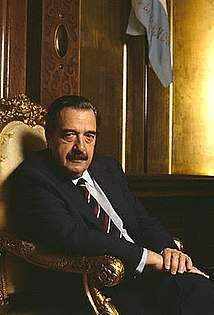 Alfonsín
Alfonsín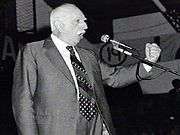 Alende
Alende Frigerio
Frigerio
Results
President
| Presidential candidate |
Vice Presidential candidate |
Party or coalition | Popular vote | Electoral vote | |||
|---|---|---|---|---|---|---|---|
| Votes | % | Votes | % | ||||
| Raúl Alfonsín | Víctor Hipólito Martínez | Radical Civic Union | 7,724,559 | 51.75 | 317 | 52.83 | |
| Ítalo Lúder | Deolindo Bittel | Justicialist Party | 5,995,402 | 40.16 | 259 | 43.17 | |
| Parties without candidates | Pacto Autonomista - Liberal | 104.052 | 0.70 | 6 | 1.00 | ||
| Partido Bloquista de San Juan | 58,038 | 0.39 | 4 | 0.67 | |||
| Neuquén People's Movement | 30,546 | 0.20 | 4 | 0.67 | |||
| Oscar Alende | Mirto Lisandro Viale | Intransigent Party | 347,654 | 2.33 | 2 | 0.33 | |
| Rogelio Julio Frigerio | Antonio Salonia | Integration and Development Movement | 177,426 | 1.19 | 2 | 0.33 | |
| Parties without candidates | Movimiento Popular Jujeño | 22,303 | 0.15 | 2 | 0.33 | ||
| Movimiento Federalista Pampeano | 15,298 | 0.10 | 2 | 0.33 | |||
| Tres Banderas | 22,583 | 0.15 | 1 | 0.17 | |||
| Salta Renewal Party | 18,844 | 0.13 | 1 | 0.17 | |||
| Francisco Manrique | Guillermo Belgrano Rawson | Alianza Federal
|
104,114 | 0.70 | |||
| Álvaro Alsogaray | Jorge Oría | Confederación Nacional
de Centro
|
60,271 | 0.40 | |||
| Rafael Martínez Raymonda | René Balestra | Alianza Demócrata Socialista
|
48,258 | 0.32 | |||
| Francisco Cerro | Arturo Ponsati | Christian Democratic Party | 46,544 | 0.31 | |||
| Luis Zamora | Silvia Díaz | Movement for Socialism | 42,500 | 0.28 | |||
| Guillermo Estévez Boero | Edgardo Rossi | Popular Socialist Party | 21,011 | 0.14 | |||
| Jorge Abelardo Ramos | Elisa Colombo | Frente de Izquierda Popular | 14,259 | 0.10 | |||
| Gregorio Flores | Catalina Guagnini | Workers' Party | 13,067 | 0.09 | |||
| Parties without candidates | Vanguardia Federal | 12,373 | 0.08 | ||||
| Cruzada Renovadora | 5,539 | 0.04 | |||||
| Movimiento Popular Catamarqueño | 4,464 | 0.03 | |||||
| Línea Popular | 4,044 | 0.03 | |||||
| Movimiento Popular Salteño | 3,197 | 0.02 | |||||
| Alianza Salteña | 3,089 | 0.02 | |||||
| Movimiento Línea Popular | 3,074 | 0.02 | |||||
| Conservador Principista | 3,000 | 0.02 | |||||
| Movimiento de Unidada Chaqueña | 2,853 | 0.02 | |||||
| La Voz del Pueblo | 2,753 | 0.02 | |||||
| Partido Acción Chubutense | 2,640 | 0.02 | |||||
| Alianza Popular | 2,568 | 0.02 | |||||
| Socialist Party | 2,289 | 0.02 | |||||
| Democratic Progressive Party | 1,926 | 0.01 | |||||
| Partido del Centro | 1,592 | 0.01 | |||||
| Partido Provincial Rionegrino | 1,113 | 0.01 | |||||
| Confederación Nacional de Centro | 991 | 0.01 | |||||
| Popular Union | 934 | 0.01 | |||||
| Authentic Socialist Party | 585 | 0.00 | |||||
| Partido Renovador de la Provincia | 448 | 0.00 | |||||
| Partido Democráta de Catamarca | 401 | 0.00 | |||||
| Movimiento Nacionalista | 394 | 0.00 | |||||
| Defensa Provincial - Bandera Blanca | 264 | 0.00 | |||||
| Partido para la Democracia Social | 257 | 0.00 | |||||
| Partido Conservador Popular | 13 | 0.00 | |||||
| Total | 14,927,512 | 100 | |||||
| Positive votes | 14,927,512 | 97.25 | |||||
| Blank votes | 334,946 | 2.18 | |||||
| Invalid votes | 87,728 | 0.57 | |||||
| Turnout | 15,350,186 | 85.61 | 600 | 100 | |||
| Abstentions | 2,579,765 | 14.39 | 0 | 0.00 | |||
| Registered voters | 17,929,951 | 100 | 600 | 100 | |||
| Source: Dirección Nacional Electoral – Recorriendo las Elecciones de 1983 a 2013 | |||||||
Results by province
| Provinces won by Raúl Alfonsín/Víctor Martínez |
| Provinces won by Ítalo Lúder/Deolindo Bittel |
| Provinces tied between Raúl Alfonsín/Víctor Martínez and Ítalo Lúder/Deolindo Bittel |
| Alfonsín/Martínez UCR |
Lúder/Bittel PJ |
Others Full list |
Blank/Invalid | Total | Registered | Turnout | |||||||||
|---|---|---|---|---|---|---|---|---|---|---|---|---|---|---|---|
| Province | Electors | # | % | Electoral votes |
# | % | Electoral votes |
# | % | Electoral votes |
# | % | |||
| Buenos Aires | 144 | 2,878,858 | 51.41 | 79 | 2,364,585 | 42.23 | 65 | 356,099 | 6.36 | – | 159,673 | 2.77 | 5,759,215 | 6,567,389 | 87.69 |
| Buenos Aires City | 54 | 1,269,352 | 64.26 | 37 | 540,389 | 27.36 | 15 | 165,516 | 8.38 | 2
|
33,422 | 1.67 | 2,008,679 | 2,341,791 | 85.78 |
| Catamarca | 14 | 48,595 | 46.79 | 7 | 45,329 | 43.65 | 7 | 9,933 | 9.57 | – | 3,762 | 3.50 | 107,619 | 132,308 | 81.34 |
| Chaco | 18 | 153,971 | 46.55 | 9 | 158,721 | 47.98 | 9 | 18,088 | 5.47 | – | 10,656 | 3.12 | 341,436 | 449,824 | 75.90 |
| Chubut | 14 | 56,912 | 50.85 | 8 | 46,400 | 41.46 | 6 | 8,600 | 7.70 | – | 5,167 | 4.41 | 117,079 | 145,205 | 80.63 |
| Córdoba | 40 | 791,470 | 56.22 | 23 | 561,954 | 39.92 | 17 | 54,412 | 3.87 | – | 33,381 | 2.32 | 1,441,217 | 1,631,287 | 88.35 |
| Corrientes | 18 | 112,216 | 33.84 | 7 | 94,105 | 28.38 | 5 | 125,246 | 37.76 | 6
|
8,232 | 2.42 | 339,799 | 439,798 | 77.26 |
| Entre Ríos | 22 | 251,811 | 49.53 | 12 | 224,778 | 44.21 | 10 | 31,808 | 6.25 | – | 11,769 | 2.26 | 520,166 | 621,499 | 83.70 |
| Formosa | 14 | 45,065 | 37.20 | 5 | 54,660 | 45.12 | 7 | 21,428 | 17.69 | 2
|
5,369 | 4.24 | 126,522 | 166,651 | 75.92 |
| Jujuy | 16 | 61,173 | 35.46 | 6 | 84,051 | 48.72 | 8 | 27,277 | 15.81 | 2
|
8,852 | 4.88 | 181,353 | 215,074 | 84.32 |
| La Pampa | 14 | 50,753 | 41.38 | 6 | 50,138 | 40.88 | 6 | 21,756 | 17.74 | 2
|
5,350 | 4.18 | 127,997 | 142,988 | 89.52 |
| La Rioja | 14 | 35,534 | 41.04 | 6 | 48,073 | 55.52 | 8 | 2,975 | 3.44 | – | 9,285 | 9.68 | 95,867 | 107,344 | 89.31 |
| Mendoza | 24 | 368,484 | 57.81 | 15 | 233,035 | 36.56 | 9 | 35,872 | 5.62 | – | 11,680 | 1.80 | 649,071 | 749,248 | 86.63 |
| Misiones | 18 | 118,676 | 49.56 | 9 | 114,454 | 47.79 | 9 | 6,340 | 2.64 | – | 11,359 | 4.53 | 250,829 | 312,945 | 80.15 |
| Neuquén | 14 | 48,279 | 45.31 | 7 | 23,653 | 22.20 | 3 | 34,612 | 32.48 | 4
|
6,006 | 5.33 | 112,550 | 129,662 | 86.80 |
| Río Negro | 14 | 84,226 | 53.57 | 8 | 62,801 | 39.94 | 6 | 10,209 | 6.48 | – | 10,447 | 6.23 | 167,683 | 195,344 | 85.84 |
| Salta | 18 | 135,398 | 44.62 | 8 | 137,369 | 45.27 | 9 | 30,651 | 10.10 | 7,677 | 2.46 | 311,095 | 388,537 | 80.07 | |
| San Juan | 16 | 98,916 | 40.23 | 7 | 75,368 | 30.65 | 5 | 71,597 | 29.12 | 4
|
4,724 | 1.89 | 250,605 | 290,040 | 86.40 |
| San Luis | 14 | 58,723 | 48.58 | 8 | 50,095 | 41.44 | 6 | 12,058 | 9.98 | – | 4,138 | 3.31 | 125,014 | 147,100 | 84.99 |
| Santa Cruz | 14 | 19,077 | 44.01 | 7 | 22,324 | 51.50 | 7 | 1,949 | 4.50 | – | 1,850 | 4.09 | 45,200 | 54,974 | 82.22 |
| Santa Fe | 42 | 719,186 | 50.21 | 23 | 615,007 | 42.94 | 19 | 98,026 | 6.84 | – | 47,401 | 3.20 | 1,479,620 | 1,676,080 | 88.28 |
| Santiago del Estero | 18 | 109,012 | 40.57 | 8 | 130,411 | 48.53 | 9 | 29,282 | 10.90 | 1
|
8,794 | 3.17 | 277,499 | 397,068 | 69.89 |
| Tierra del Fuego | 4 | 5,410 | 50.40 | 2 | 4,180 | 38.94 | 2 | 1,144 | 10.66 | – | 3,166 | 22.78 | 13,900 | 15,349 | 90.56 |
| Tucumán | 22 | 203,462 | 41.55 | 10 | 253,522 | 51.78 | 12 | 32673 | 6.68 | – | 10,514 | 2.11 | 500,171 | 612,446 | 81.67 |
| Totals | 600 | 7,724,559 | 51.75 | 317 | 5,995,402 | 40.16 | 259 | 1,207,551 | 5.34 | 24 | 422,674 | 2.75 | 15,350,186 | 17,929,951 | 85.61 |
Argentine Congress
| Party/Electoral Alliance | Lower House Seats |
% of votes | Senate |
|---|---|---|---|
| UCR | 129 | 48.0% | 18 |
| Justicialist Party | 111 | 38.5% | 20 |
| Intransigent Party | 3 | 2.8% | |
| UCeDé | 2 | 1.2% | |
| Autonomist-Liberal Pact (Corrientes Province) |
2 | 0.8% | 2 |
| People's Movement (Neuquén Province) |
2 | 0.2% | 2 |
| Bloc (San Juan Province) |
2 | 0.4% | 2 |
| Christian Democratic | 1 | 1.0% | |
| Others | 2 | 7.1% | 2 |
| Invalid votes | 3.5% | ||
| Total | 254 | 100.0% | 46 |
Electoral system: Proportional representation by districts according to the D'Hondt method. Seats are divided among those lists of candidates from parties or electoral alliances that obtain at least 3% of the electoral census or working electoral of the district.
Governors
| Election of Provincial Governors | |||
|---|---|---|---|
| Elected: 22 provincial governors, 24 legislative bodies
Presidential appointment: Mayor of the City of Buenos Aires and Territorial Governor of Tierra del Fuego | |||
| Province | Elected | Party | Map |
| Buenos Aires | Alejandro Armendáriz | Unión Cívica Radical | 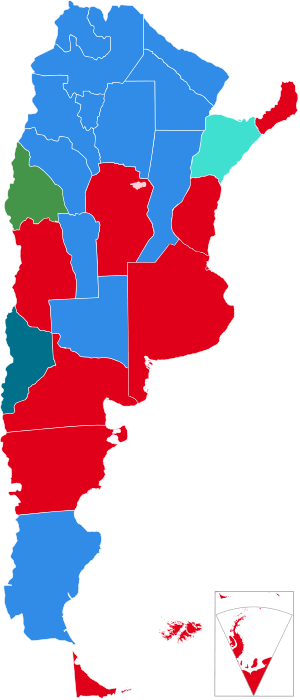 |
| Catamarca | Ramón Saadi | Partido Justicialista | |
| Chaco | Florencio Tenev | Partido Justicialista | |
| Chubut | Atilio Viglione | Unión Cívica Radical | |
| Córdoba | Eduardo Angeloz | Unión Cívica Radical | |
| Corrientes | José Antonio Romero Feris | Pacto (Partido Autonomista) | |
| Entre Ríos | Sergio Montiel | Unión Cívica Radical | |
| Formosa | Floro Bogado | Partido Justicialista | |
| Jujuy | Carlos Snopek | Partido Justicialista | |
| La Pampa | Rubén Marín | Partido Justicialista | |
| La Rioja | Carlos Menem | Partido Justicialista | |
| Mendoza | Santiago Llaver | Unión Cívica Radical | |
| Misiones | Ricardo Barrios Arrechea | Unión Cívica Radical | |
| Neuquén | Felipe Sapag | Movimiento Popular Neuquino | |
| Río Negro | Osvaldo Álvarez Guerrero | Unión Cívica Radical | |
| Salta | Roberto Romero | Partido Justicialista | |
| San Juan | Leopoldo Bravo | Partido Bloquista | |
| San Luis | Adolfo Rodríguez Saá | Partido Justicialista | |
| Santa Cruz | Arturo Puricelli | Partido Justicialista | |
| Santa Fe | José María Vernet | Partido Justicialista | |
| Santiago del Estero | Carlos Juárez | Partido Justicialista | |
| Tucumán | Fernando Riera | Partido Justicialista | |
| Capital Federal | Julio César Saguier | Unión Cívica Radical | |
| Tierra del Fuego | Ramón Alberto Trejo Noel | Unión Cívica Radical | |
Notes
- Todo Argentina: 1982 (in Spanish)
- Todo Argentina: 1983 (in Spanish)
- Página/12: El marketing que acompañó al candidato (in Spanish)
- Argentine Interior Ministry Archived 2009-03-26 at the Wayback Machine
- Dirección Nacional Electoral Archived 2009-03-26 at the Wayback Machine

